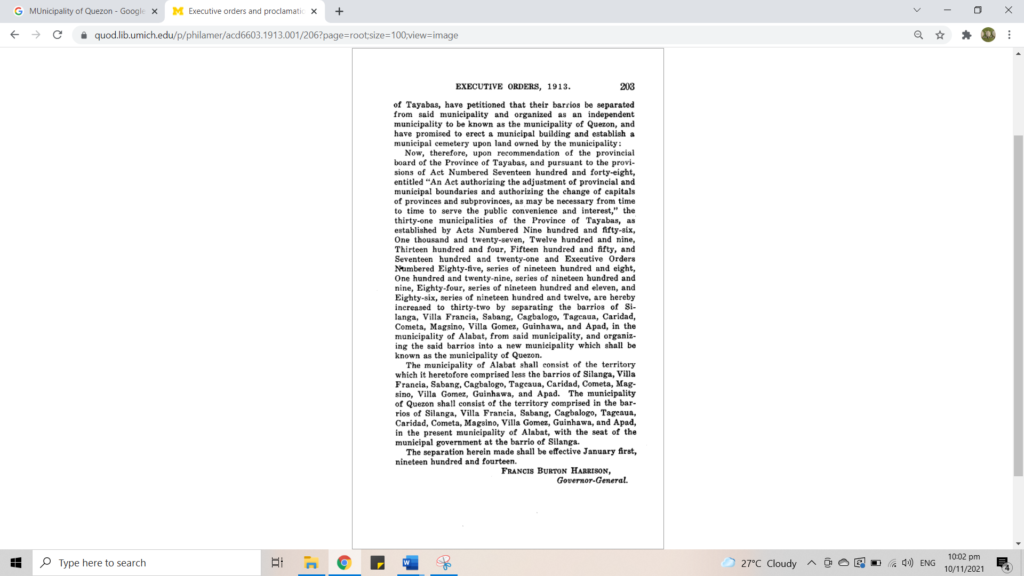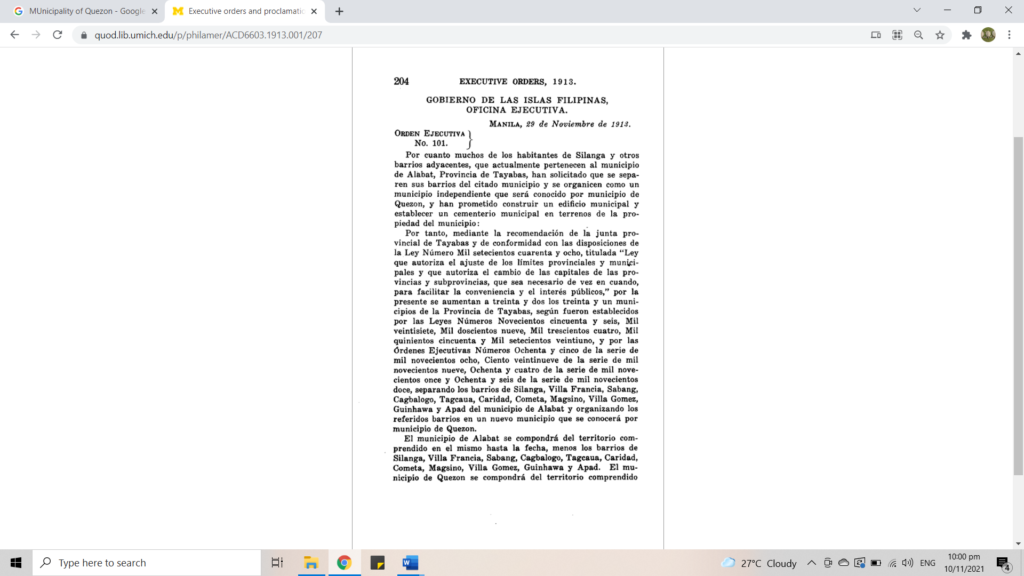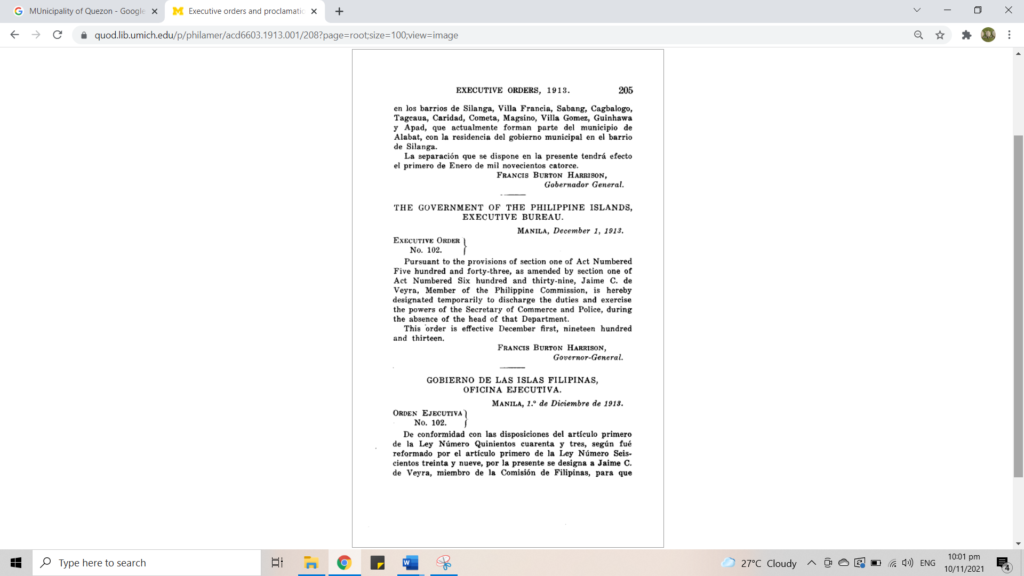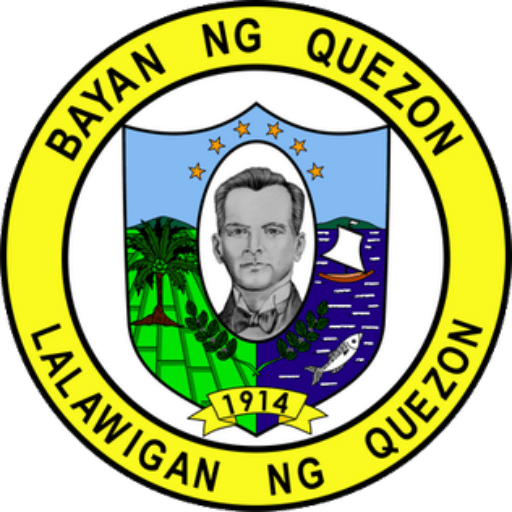History of Municipality of Quezon, Province of Quezon
Brief History of the Municipality of Quezon, Quezon
About the time the Philippine Archipelago was discovered by the Spaniards, there were already inhabitants in the place; the exact date of their settlements was unrecorded. Those people have dark brown complexion, though few have lighter, their height was about four feet and a half, commonly robust, semi-nomad, they commonly wandered along the coast where they gather most of their goods. Their mode of life and settlements was similar to the common Malay. They were also called “Dumagats” because they spent most of their time in the sea. Further inland there was a little village formed by wandering Malays from which their origin was unknown. They were distinctly separated from the Dumagats who wandered along the coast. They had already carried some trade with the people from Atimonan, Mauban and Binangonan.
In the earlier part of the year 1672, a boat bearing Franciscan friar was drifted by the outgoing current from Atimonan to a village from this town. Fray Tirso de Santa Maria and ten members of the party explored the place and discovered the fertility of the soil and site for a prospective town. Immediately they returned to Atimonan and summoned a congregation for the purpose of transfer. They invited some families from Mauban and set sail for Silangan. Upon arrival to their destination, they found a village and constructed a church. (The ruins of this church can still be seen under the roots of a great Balete tree that grew in it.) Several hundreds of houses were constructed, some were made of stones, the ruins of which were now entirely covered by the roots of the coconut trees that were planted. They lasted for fifteen years and these friars were also the priests and governadorcillos at that time. The town was built covering the southern part of the island, fortifications was built by enormous labor and money, so no strong port was built to protect the people from pirate attacks which was quite numerous by that time.
In 1688, the friars guarded the coastline along Lamon Bay, they chose a site near the river just opposite to the west of the established town, and today it was known as the town of “Gumaca”. The people of Gumaca under fray Diego de Alcala had built stone fortifications and watch tower against pirates who become discouraged and by the middle of 18th century the moro pirates stopped their perilous adventure.
More people began to cross the channel and settled in the forgotten town. More and more people established their homes permanently in the barrio until there were about a thousand inhabitants when the revolution against the Spanish dominations commenced. They called the place “Silangan” signifying the rising sun.
Quezon, Quezon was formally instituted as a town on January 1, 1914 naming the locality after the most honored son of the province, then Commissioner Manuel L. Quezon, through the Executive Order No. 101 Series of 1913 issued by Governor Burton Harrison composing of 11 barrios. As the town progressed and population increased additional barrios were established. Quezon, Quezon now is composed of 24 barangays – 18 rural barangays (9 barangays in the Pacific Ocean/Calauag Bay side and 9 barangays in the Lamon Bay side) and 6 urban (poblacion) barangays.
The municipality of Quezon is host to the mystifying giant trees of Balete Park and the charming cascades of Sabang Falls. While exploring the town, share a lunch with the locals and try their savory takla, a delicious shellfish prepared in various ways. Come in May and join the feast laid out on the streets in celebration of the Yubakan Festival.
EXECUTIVE ORDERS, 1913. Page 203
EXECUTIVE ORDER No. 101.}
Whereas many of the inhabitants of Silanga and other adJacent barrios, now in the municipality of Alabat, Province of Tayabas, have petitioned that their barrios be separated from said municipality and organized as an independent municipality to be known as the municipality of Quezon, and have promised to erect a municipal building and establish a municipal cemetery upon land owned by the municipality: Now, therefore, upon recommendation of the provincial board of the Province of Tayabas, and pursuant to the provisions of Act Numbered Seventeen hundred and forty-eight, entitled “An Act authorizing the adjustment of provincial and municipal boundaries and authorizing the change of capitals of provinces and subprovinces, as may be necessary from time to time to serve the public convenience and interest,” the thirty-one municipalities of the Province of Tayabas, as established by Acts Numbered Nine hundred and fifty-six, One thousand and twenty-seven, Twelve hundred and nine, Thirteen hundred and four, Fifteen hundred and fifty, and Seventeen hundred and twenty-one and Executive Orders Numbered Eighty-five, series of nineteen hundred and eight, One hundred and twenty-nine, series of nineteen hundred and nine, Eighty-four, series of nineteen hundred and eleven, and Eighty-six, series of nineteen hundred and twelve, are hereby increased to thirty-two by separating the barrios of Silanga, Villa Francia, Sabang, Cagbalogo, Tagcaua, Caridad, Cometa, Magsino, Villa Gomez, Guinhawa, and Apad, in the municipality of Alabat, from said municipality, and organizing the said barrios into a new municipality which shall be known as the municipality of Quezon. The municipality of Alabat shall consist of the territory which it heretofore comprised less the barrios of Silanga, Villa Francia, Sabang, Cagbalogo, Tagcaua, Caridad, Cometa, Magsino, Villa Gomez, Guinhawa, and Apad. The municipality of Quezon shall consist of the territory comprised in the barrios of Silanga, Villa Francia, Sabang, Cagbalogo, Tagcaua, Caridad, Cometa, Magsino, Villa Gomez, Guinhawa, and Apad, in the present municipality of Alabat, with the seat of the municipal government at the barrio of Silanga. The separation herein made shall be effective January first, nineteen hundred and fourteen.
FRANCIS BURTON HARRISON, Governor-General.
EXECUTIVE ORDERS, 1913. Pages 204-205
GOBIERNO DE LAS ISLAS FILIPINAS, OFICINA EJECUTIVA. MANILA, 29 de Noviembre de 1913. ORDEN EJECUTIVA No. 101.
Por cuanto muchos de los habitantes de Silanga y otros barrios adyacentes, que actualmente pertenecen al municipio de Alabat, Provincia de Tayabas, han solicitado que se separen sus barrios del citado municipio y se organicen como un municipio independiente que sera conocido por municipio de Quezon, y han prometido construir un edificio municipal y establecer un cementerio municipal en terrenos de la propiedad del municipio: Por tanto, mediante la recomendaci6n de la junta provincial de Tayabas y de conformidad con las disposiciones de la Ley Numero Mil setecientos cuarenta y ocho, titulada “Ley que autoriza el ajuste de los limites provinciales y municipales y que autoriza el cambio de las capitales de las provincias y subprovincias, que sea necesario de vez en cuando, para facilitar la conveniencia y el interes publicos,” por la presente se aumentan a treinta y dos los treinta y un municipios de la Provincia de Tayabas, segufn fueron establecidos por las Leyes Numeros Novecientos cincuenta y seis, Mil veintisiete, Mil doscientos nueve, Mil trescientos cuatro, Mil quinientos cincuenta y Mil setecientos veintiuno, y por las 6rdenes Ejecutivas Numeros Ochenta y cinco de la serie de mil novecientos ocho, Ciento veintinueve de la serie de mil novecientos nueve, Ochenta y cuatro de la serie de mil novecientos once y Ochenta y seis de la serie de mil novecientos doce, separando los barrios de Silanga, Villa Francia, Sabang, Cagbalogo, Tagcaua, Caridad, Cometa, Magsino, Villa Gomez, Guinhawa y Apad del municipio de Alabat y organizando los referidos barrios en un nuevo municipio que se conocera por municipio de Quezon. El municipio de Alabat se compondra del territorio comprendido en el mismo hasta la fecha, menos los barrios de Silanga, Villa Francia, Sabang, Cagbalogo, Tagcaua, Caridad, Cometa, Magsino, Villa Gomez, Guinhawa y Apad. El municipio de Quezon se compondra del territorio comprendido en los barrios de Silanga, Villa Francia, Sabang, Cagbalogo, Tagcaua, Caridad, Cometa, Magsino, Villa Gomez, Guinhawa y Apad, que actualmente forman parte del municipio de Alabat, con la residencia del gobierno municipal en el barrio de Silanga. La separaci6n que se dispone en la presente tendra efecto el primero de Enero de mil novecientos catorce. FRANCIS BURTON HARRISON, Gobernador General.
References:
- https://quod.lib.umich.edu/p/philamer/ACD6603.1913.001?rgn=main;view=fulltext
- University of Michigan Library, Digital Content and Collections. Title: Executive orders and proclamations issued by the governor-general. [1913] Author: Philippines. Governor. Collection: The United States and its Territories, 1870 – 1925: The Age of Imperialism https://quod.lib.umich.edu/p/philamer/ACD6603.1913.001/202-208
- https://quezon.gov.ph/municipality/quezon








